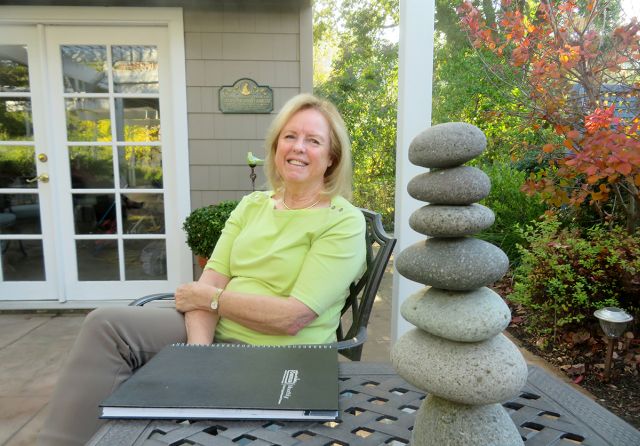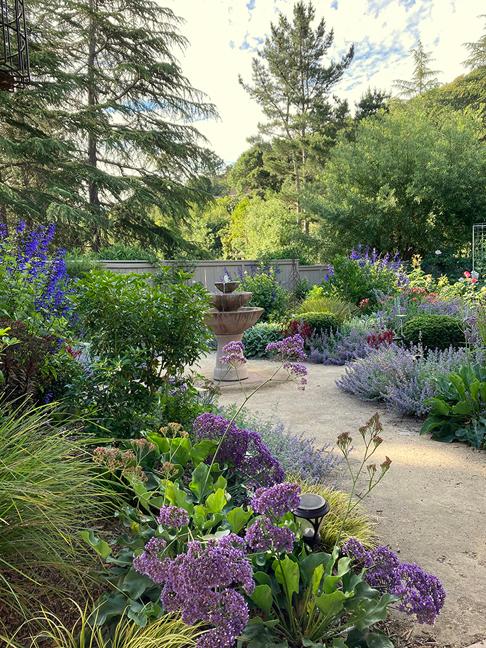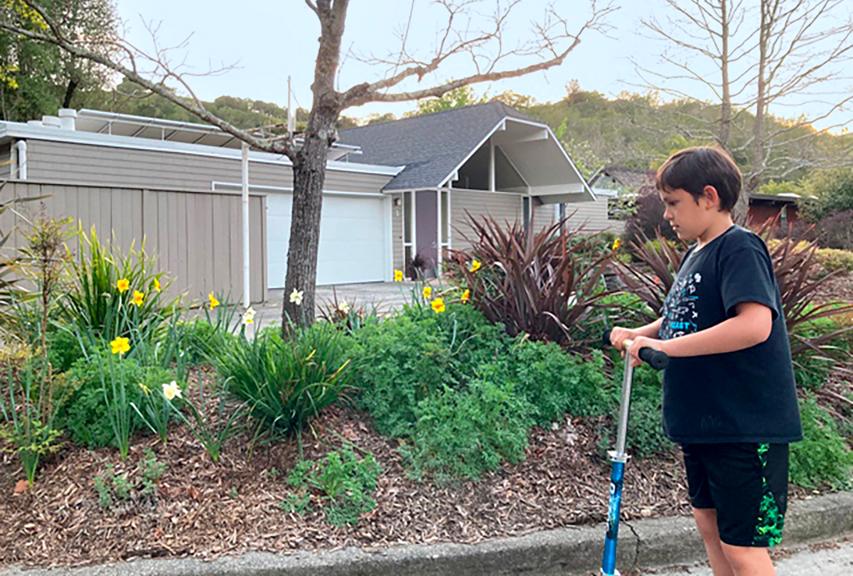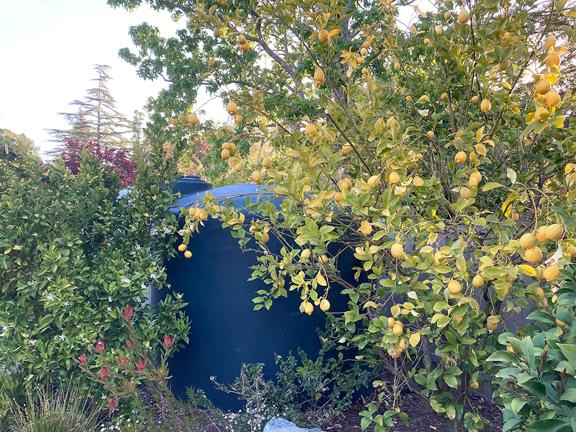
Habitat and Roses Grace an Eichler Garden
 |
There’s a creekside trail within view of Patti Vance’s backyard, but often when she goes for a walk she never leaves the backyard.
“There are crushed granite pathways that loop around here. It’s almost like a möbius [strip],” she says of the path. “So it goes out and around, and then back here, and it’ll loop. So when I talk to my sister in Colorado, I get out here and I do my walk. It’s great. It’s actually a tenth of a mile from that gate all the way around the loop.”
Patti lives in an Eichler in a compact tract in Sleepy Hollow, an unincorporated area in Central Marin County. Lots are large, and many open directly onto Sleepy Hollow Creek. Wooded hillsides overlook the valley, so it is a grand place for wildlife.
But in the world today, with habitat loss, pollution, and climate change, wildlife needs help. Patti helps, both at home and beyond.
She started with her garden. Patti, who’s been a gardener – “I think forever, right?” – didn’t focus on it so much until the two sons she and her late husband raised here were out of the house and the yard no longer had to be preserved for their use. She has lived in the home since 1974, shortly after it was built.
 |
They did some changes in the house about five years after moving in, and extended the Eichler look into the backyard by building a large trellis that employs Eichler-style beams to create a shaded sitting area.
The structure was designed to integrate with the architecture of the house. “Look at how beautifully this flat line of the roof comes out and joins these trellises. I just think it expands the outdoor living space,” she says.
Her garden has two parts: traditional on one side, filled with rose bushes; and a garden devoted to wildlife habitat on the other.
“There may be 40 rose bushes in there,” she says of the traditional side, “so that was more of the English garden idea. And then this side is more of a habitat garden for native plants and a pollinator garden for insects. I have a lot of milkweed I put in for the monarchs that are disappearing. It’s to see if I can help out with that.”
The garden has been declared “certified wildlife habitat.” Wildlife cams reveal foxes that visit the garden, and owls.
 |
“This is a pineapple salvia,” she says. “It’s one of those few things that starts blooming right when the season changes – where it’s 12 hours of daylight, 12 hours of nighttime. Well, of course, you know, the hummingbirds are desperate for food in the winter, and so they really appreciate this.”
“Mostly I’m kind of into birds, so I do have some feeders out and I really enjoy the birds. They enjoy the the garden, the fountain out there. I have a a red-tailed hawk, or maybe a Cooper’s hawk, that is nested in one of these redwood trees.”
Wait a minute. Bird baths in view of a cooper’s hawk perch?
“I’m with an organization, it’s called Point Blue Conservation Science. We do a lot to create habitat restoration for birds and other animals. And somebody told me with the organization that a third of the hawks die from starvation, which I thought was really interesting.
“I’m not happy that they come in and they swoop through. It’s almost breathtaking. They come in so quickly, they’ll stop at the bird feeder and they’ll wrap their wings around, snatch the bird and off they go.”
“They have to eat, too.”
 |
The water shortage in Marin County is worse than in many locales that bring in water from the Sierra. Patti creates rooftop rainwater for storage in a 2,500-gallon tank. It helps a lot. “You have to know,” she says, “that one inch of rain on a thousand square feet will equal 600 gallons.”
For Point Blue, Patti volunteers for a program called STRAW – “students and teachers restoring a watershed.”
“Each year we work with three to four thousand students from kindergarten through 12th grade, and it’s all free. We have teachers go out to points all over the North Bay, the Peninsula, and South Bay and do riparian restorations along creeks or wetlands.”
Back home, Patti concedes that keeping her garden going takes lots of work. She hired a landscaper to help put in the roses, but otherwise she is on her own.
“Martha Stewart said, I’m not going to ‘work in the garden, I’m going to garden.’ I’m gardening, I’m not going to work in the garden. It’s calming to be out here for me, to be clipping things. And yeah, it’s lovely.”
“It’s calm. It’s beauty. We all need to have the outdoor in our lives.”
- ‹ previous
- 290 of 677
- next ›



